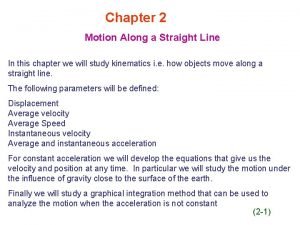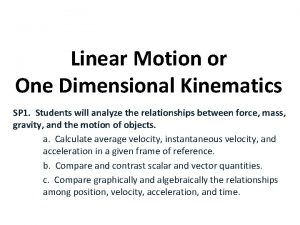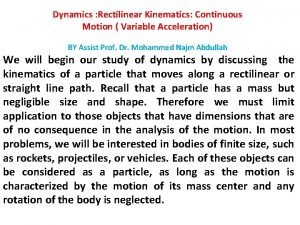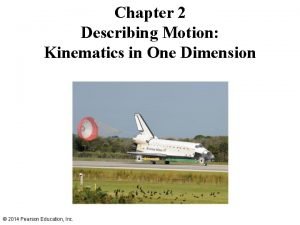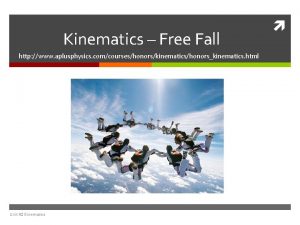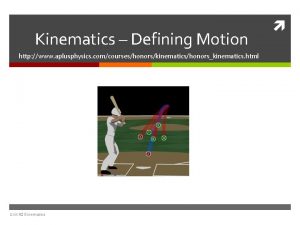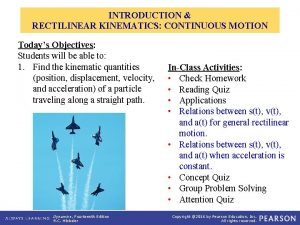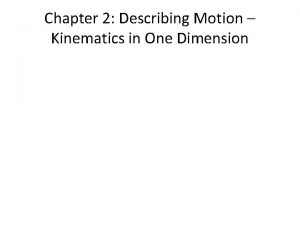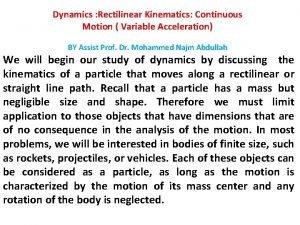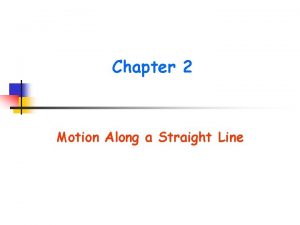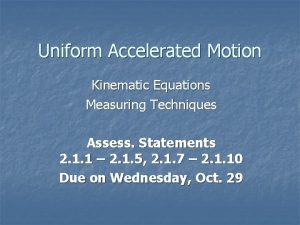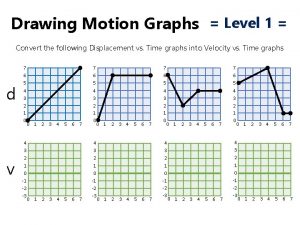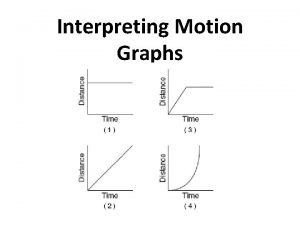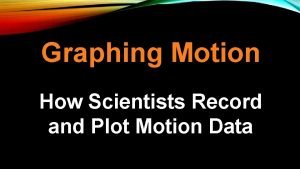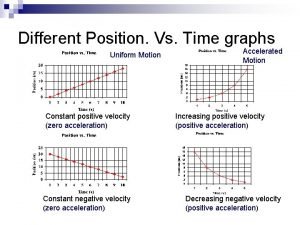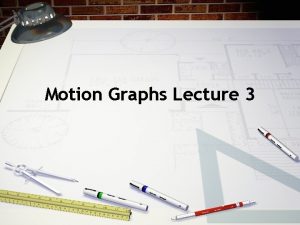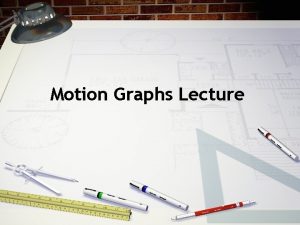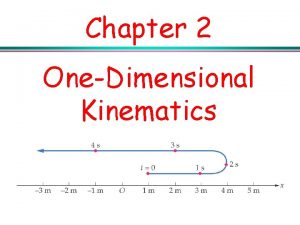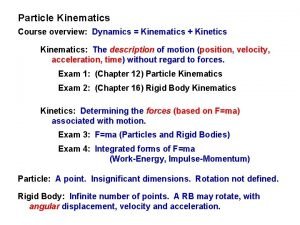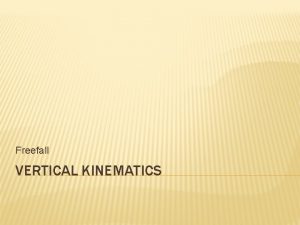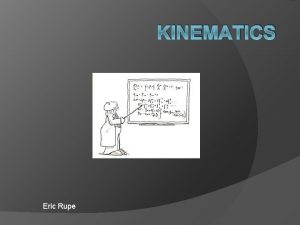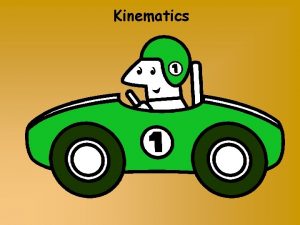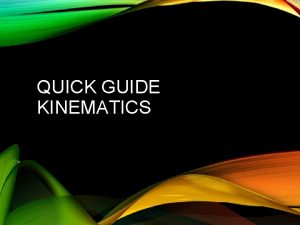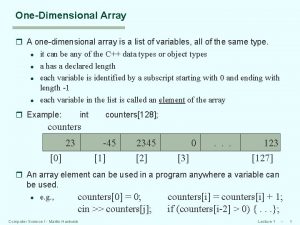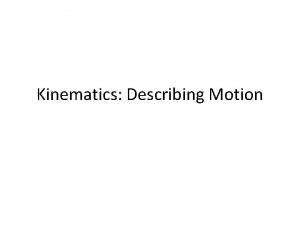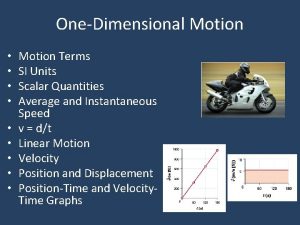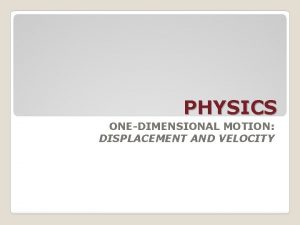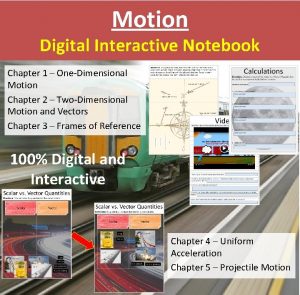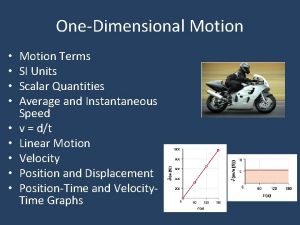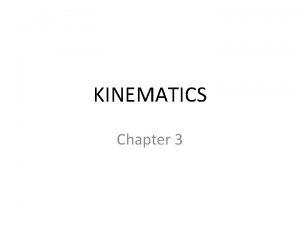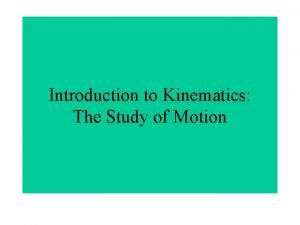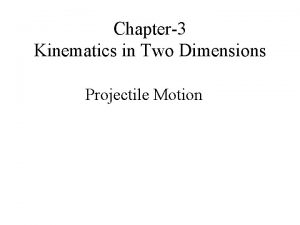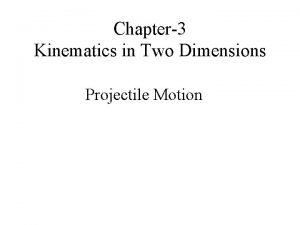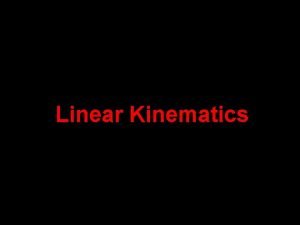Kinematics Graphs OneDimensional Motion Graphs provide an easy



























- Slides: 27

Kinematics Graphs One-Dimensional Motion Graphs provide an easy tool for understanding and communicating how objects move. Objectives to learn how to interpret kinematics graphs in the study of physics.

Using technology to determine position, speed, and acceleration THE MOTION DETECTOR: Often times in physics class we use a device called a motion detector to sonically range our location from a computer data acquisition probe. The following slides are examples of real data take from such a device and computer data analysis set up.

Distance (postion) vs. Time Graphs An example of a Distance vs. Time graph is shown below

The Velocity vs. Time graph is shown below:

Velocity vs. Time Graphs

The Velocity vs. Time graph is shown below: This data was recorded by moving a cart in front of a motion detector on a long track. Similar to the set up shown in the figure above.

Drawing a Velocity vs. Time Graph Analysis from Distance vs. Time data Time Interval Initial Distance (x 0) Final Distance (x) Time Elapsed (t) Velocity (v) 0 - 3 sec. 2 meters 7 meters 3 seconds 1. 67 m/s 3 - 6 sec. 7 meters 3 seconds 0 m/s 6 - 8 sec. 7 meters 1 meter 2 seconds -3 m/s 8 - 12 sec. 1 meter 4 seconds 0 m/s

The Velocity vs. Time graph is shown below:

Working backward? We will now show you a velocity graph and then the distance graph in an animation…

Kinematics Equations & Graphs

Relating the Equations to Graphs • If you are given any kinematics graph (e. g. Velocity vs. Time), you can use that to determine other graphs (e. g. Distance vs. Time or Velocity vs. Time) using the 3 kinematics equations of motion. Below is an example. . . Given the following Velocity vs. Time graph. . .

The corresponding Acceleration vs. Time graph is shown below:

Another example of using graphs and equations is given below. . • Suppose you are given the following Acceleration vs. Time graph. • You can find the corresponding Velocity vs. Time graph using the 1 st equation of motion.

The corresponding Velocity vs. Time graph is shown below: Using both the Velocity vs. Time graph as well as the Acceleration vs. Time graph, we can determine the Displacement vs. Time graph using the second equation of motion:

The corresponding Displacement vs. Time graph is shown below. Note each line segment on the Velocity vs. Time graph corresponds to a parabola on the Displacement vs. Time graph.

Calculating the Average Velocity • Average velocity is related to the Total Displacement and Total Time as follows: For the above graph, the Average Velocity can be calculated as follows. Note that the average velocity is also the mean of the initial (v 0)and final (v) velocities in the time interval.

Physics Simulations and Tools There a number of great tools that can be used to help you understand how to make these graphs and motion seem sensible. One of them is housed at the Ph. ET site at the university of Colorado. Take time to go out and play with the Moving Man software. It is free and has proven to be useful to a number of students. In the past. http: //phet. colorado. edu/en/simulation/movi ng-man

More physics simulations and tools There a number of great tools that can be used to help you understand how to make these graphs and motion seem sensible. One of them is housed at the Addison Wesley textbook site called Activphysics. Take time to go out and play with the various problem set examples. It is free and has proven to be useful to a number of students in the past. http: //wps. aw. com/aw_young_physics_11/13/ 3510/898587. cw/nav_and_content/index. html

Now that you understand how to describe motion in many methods… You will change your focus to applying the concepts of the mathematical tool known as the “Vector” to also assist you in making calculations related to kinematic quantitates. Follow the arrow you continue along the path into the next part of the lesson on Vectors.

Vectors Objectives: By the end of this lesson you will be able to apply the mathematical properties of vectors to additional vector based physics problems. Additionally, You will understand vectors in multiple forms: i. e. A vector is a quantity that has both magnitude and direction. For instance, velocity is a vector, because it has two pieces of information 1) How fast something is moving. 2) In which direction it is moving.

Representing Vectors Often, it is inconvenient to draw pictures to represent something, so people still look for ways in which to describe it merely with numbers, even if they have to use more than one number.

Rectangular or Cartesian Representation. • The two numbers Ax and Ay are called the components of the vector A. (Note: Vectors are usually denoted with bold face letters, or letters with arrows above them. ) • So Vector A = (Ax , Ay) or in this example A = (68. 9 mph , 12. 2 mph) This representation is called the rectangular or Cartesian representation.

Polar representation. There is another way in which you can represent a vector using two numbers: Polar representation. In a way we have already been using this representation. Basically the two numbers are the length (magnitude) of the vector and the direction (angle measured with respect to the positive 'x' axis in the counterclockwise direction).

Vector Algebra: Adding and Subtracting Vectors When adding and subtracting vectors, it is most convenient to do so in the Cartesian representation. So if you are given, two or more vectors in the Polar representation, first convert them to the Cartesian representation, and the add or subtract them. Suppose: A = (Ax , Ay) and B = (Bx , By) • Then, if C = A + B, you have C = (Cx , Cy), where Cx = Ax + Bx and Cy = Ay + By • Also, if D = A - B, you have D = (Dx , Dy), where Dx = Ax - Bx and Dy = Ay - By

Vector Algebra: Adding and Subtracting Vectors

Similarly…

To your chapter for problem sets. You should now have a basic understanding of how to represent motion via a number of methods. These multiple representations are the best way I know to help you learn to understand the applications of motion in physics. Ask your instructor for any specific homework assignment beyond this point.
 Aplusphysics kinematics-horizontal kinematics
Aplusphysics kinematics-horizontal kinematics Motion along a straight line
Motion along a straight line The ticker tape case graph
The ticker tape case graph Example of variable acceleration
Example of variable acceleration Kinematics of simple harmonic motion
Kinematics of simple harmonic motion Describing motion kinematics in one dimension
Describing motion kinematics in one dimension Kinematics defining motion answer key
Kinematics defining motion answer key Aplusphysics kinematics-defining motion answers
Aplusphysics kinematics-defining motion answers Rectilinear kinematics
Rectilinear kinematics Describing motion kinematics in one dimension
Describing motion kinematics in one dimension Rectilinear motion with variable acceleration
Rectilinear motion with variable acceleration Motion along a straight line formulas
Motion along a straight line formulas Rectilinear kinematics
Rectilinear kinematics Trajectory equation of projectile
Trajectory equation of projectile Kinematic equations rearranged
Kinematic equations rearranged Deductive v inductive reasoning
Deductive v inductive reasoning Every quiz has been easy. therefore the quiz will be easy
Every quiz has been easy. therefore the quiz will be easy Example of a deductive argument
Example of a deductive argument Comparing distance/time graphs to speed/time graphs
Comparing distance/time graphs to speed/time graphs Graphs that enlighten and graphs that deceive
Graphs that enlighten and graphs that deceive End behavior chart
End behavior chart Zczc state graph
Zczc state graph Drawing motion graphs level 2
Drawing motion graphs level 2 Interpreting motion graphs
Interpreting motion graphs Motion graphs warm up answer key
Motion graphs warm up answer key Http //camillasenior.homestead.com/motion graphs.pdf
Http //camillasenior.homestead.com/motion graphs.pdf Motion graph story book project
Motion graph story book project Constant rightward velocity
Constant rightward velocity

